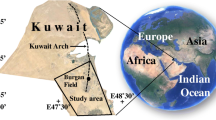Abstract
Heavy oil is commonly distributed in the Erlian Basin, North China. It can be divided into two genetic types: the primary and the secondary. Primary heavy oil is generated directly by Cretaceous immature or low-mature hydrocarbon sources, or is derived from differentiation of crude oil during migration. Oil of this type has viscosity varying in the range of 100–5000 mPa · s. By contrast, secondary heavy oil, which has been thickened to various degrees, is resultant from a combination of biodegradation, water-leaching and oxidation of primary heavy oil. Based upon a large number of determinations on the physical properties of crude oil, GC analyses of saturated and aromatic hydrocarbons, and GC-MS analyses of steranes and terpanes, the characteristics of heavy oil of various types have been described. Differences in inspissation degree have made it possible the grouping of heavy oil of the Erlian Basin into an inspissation series, i. e., low maturity and immature heavy oil with viscosity of 100–2000 mPa · s, weakly biodegradated heavy oil with viscosity of 500–5000 mPa · s, moderately biodegradated heavy oil with viscosity of 1000–50000 mPa · s and highly biodegradated heavy oil with viscosity over 50000 mPa · s. With the progress of inspissation, the products vary from common heavy to over-heavy oil. Slope and uplifted areas inside a reservoir basin are most favorable to the inspissation and formation of heavy oil. Interaction of several mechanisms of inspissation has resulted in a widespread distribution of heavy oil within the Erlian Basin.
Similar content being viewed by others
References
Connan J., Bouroullec D., Dessort D., and Albrecht P. (1986) The microbial input in carbonate-anbydrite facies of a sabkha palacoenvironment from Guatemala: A molecular approach [J]Org. Geochem. 10, 29–50.
Dou Lirong, Xu Shubao, Zhu Yuheng et al. (1995) Formation and geochemical characteristics of heavy oil pool in the Erlian Basin [J].Acta Petrolei Sinica. 16, 2–3 (in Chinese with English abstract).
Fei Baosheng, Zhu Yuheng, Zhou Weihong et al. (2001)Geology of Oil and Gas in the Erlian Rift Basin [M]. pp. 114–121. Petroleum Industry Publishing House, Beijing (in Chinese).
Graham S. A. and Williams L. A. (1985) Tectonic, depositional and diagenetic history of Monterey Formation (Miocene), Central San Joaquin Basin, California [J].AAPG. 69, 386–411.
Grantham P. J. (1986) The occurrence of unusual C27 and C29 sterane predominances in two types of Oman crude oil [J].Org. Geochem. 11, 1–10.
Hu Jianyi, Xu Shubao, Cheng Keming et al. (1989) Geology and geochemistry evidence for the formation of heavy oil in China [J].Acta Petrolei. Sinica. 10, 5–7 (in Chinese with English abstract).
Liu Baoquan, Qing Jianzhong, Wang Jing et al. (1999) Simulation experimentation of generated hydrocarbon on immature-lower mature oil in Jizhong Depression and Erlian Basin. InWorks of Exploration and Exploitation of Huabei Petroleum (1999) [C]. pp. 67–72. Petroleum Industry Publishing House, Beijing (in Chinese).
Liu Wenzhang (1989)Collected Works of International Symposium on Exploitation of Heavy Oil [M]. pp. 43–45. Petroleum Industry Publishing House, Beijing (Chinese version).
Peters K. E. and Moldowan J. M. (1990)The Biomarker Guide, Interpreting Molecular Fossils in Petroleum and Ancient Sediments [M]. pp. 627–632. Prentice Hall, Englewood Cliffs, New Jersey.
Stahl W. J. (1980) Compositional changes and13C/12C fractionations during the degradation of hydrocarbons by bacteria [J].Geochim. Cosmochin. Acta. 44, 1903–1967.
Tang Jieting, Tian Zhangxue, Su Qiang et al. (1992) Evaluation on resource of inspissation oil in the Erlian Basin. InWorks of Exploration and Exploitation of Huabei Petroleum (1992) [M]. pp. 57–61. Petroleum Industry Publishing House, Beijing (in Chinese).
Tissot B. P. and Weletal D. H. (1978)Petroleum Formation and Occurrence: A New Approach to Oil and Gas Exploration [M]. pp. 50–70, 251 – 253, Springer-Valag, Berlin.
Wang Xingshi, Liu Heping, Liu Jianjun et al. (1996) Study on formation condition and exploitation direction of Mesozoic oil and gas reservoirs in Yuanbaoshan Depression. InWorks of Exploration and Exploitation of Huabei Petroleum (1996) [M]. pp. 215–216. Petroleum Industry Publishing House, Beijing (in Chinese).
Wang Xueping and Liang Digang (1989) Characteristics of generative hydrocarbon layers and migration oil and gas in the Erlian Basin. InEvaluation of Hydrocarbon Source Rocks on Petroliferous Basin in China [C] (eds. Huang Difan et al.). pp. 355–356. Petroleum Industry Publishing House, Beijing (in Chinese).
Zeng Xianzhang, Liang Digang, Wang Zhongran et al. (1989)Biomarkers of Continental Facies Oil and Source Rock in China. Gansu [M]. pp. 125–126. Gansu Science and Technology Publishing House, Lanzhou (in Chinese).
Zhou Weihong, Fang Jie, Liu Qunqi et al. (1991) Evaluation of resource and occurrence of inspissation oil in Jizhong Depression. InWorks of Exploration and Exploitation of Huabei Petroleum [M]. pp. 19–20. Petroleum Industry Publishing House, Beijing (in Chinese).
Author information
Authors and Affiliations
Rights and permissions
About this article
Cite this article
Fang, J., Gu, L. Geochemistry and genesis of heavy oil in the Erlian Basin. Chin. J. Geochem. 24, 57–66 (2005). https://doi.org/10.1007/BF02869689
Issue Date:
DOI: https://doi.org/10.1007/BF02869689




